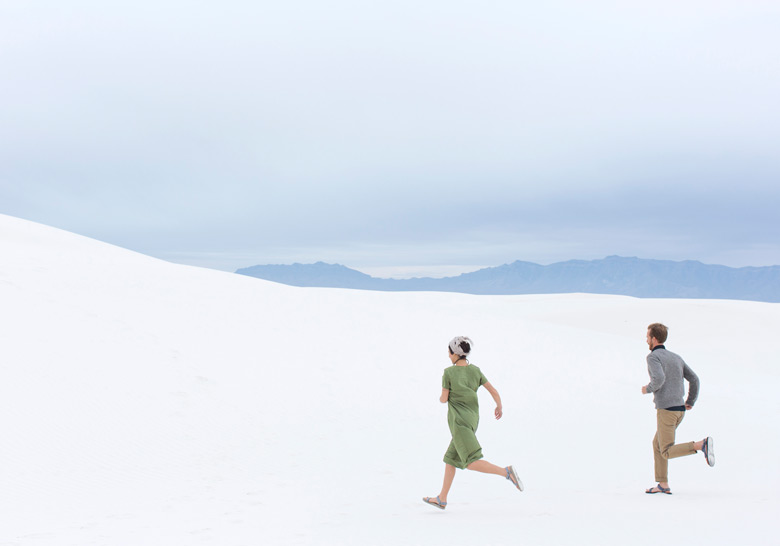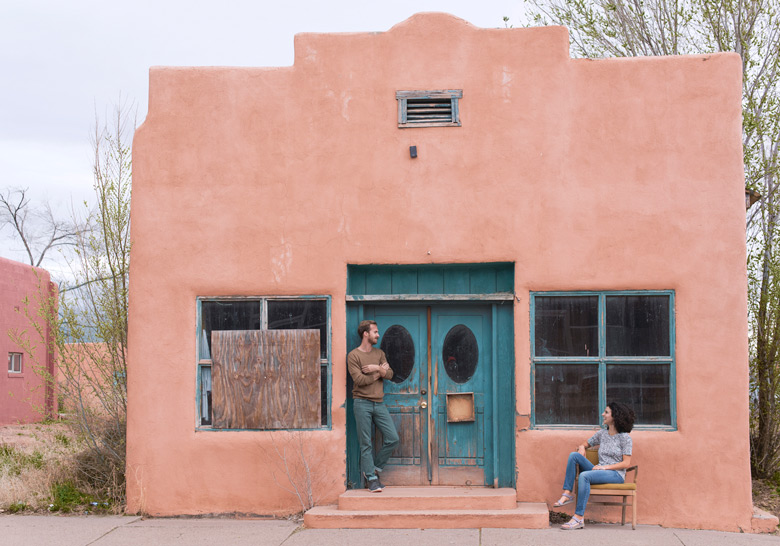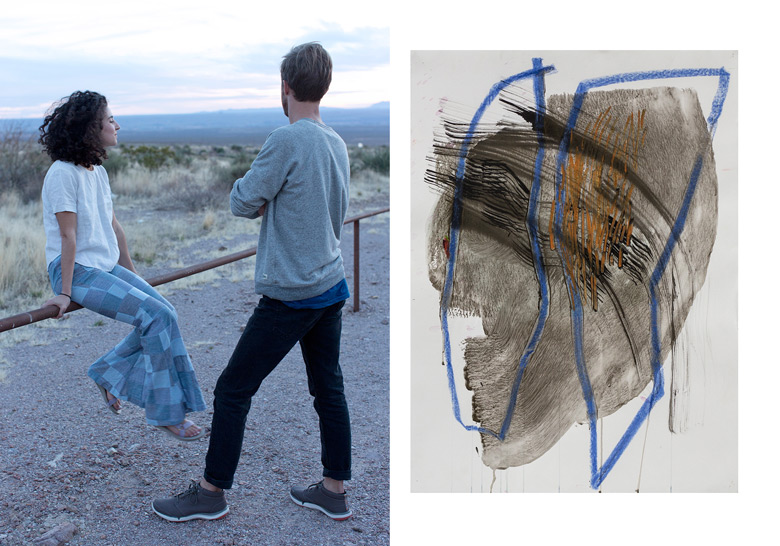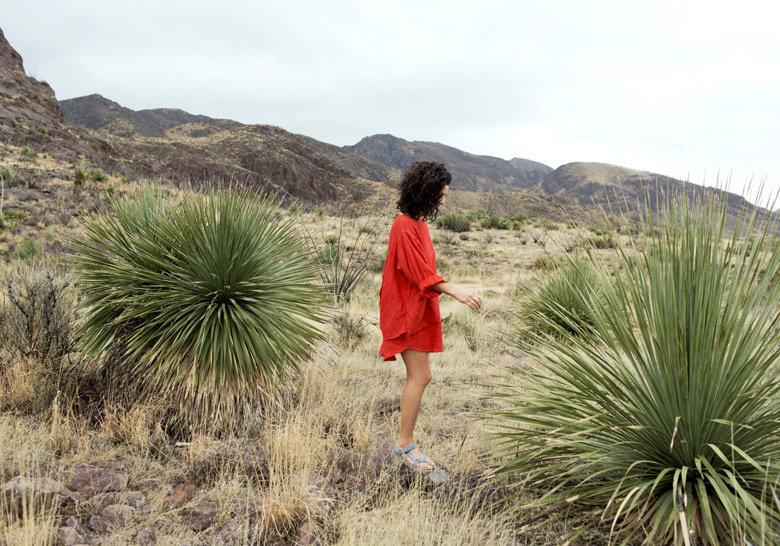
Driving into White Sands National Monument the park road fades from black asphalt to white sugar as it winds between rows of billowy bright dunes. It is difficult to find a place to rest your eyes. Looking for color along the horizon, the starkness is disorienting. Everything is white. Today, storm clouds gather where sky and land meet with surprising contrast—indigo above, ivory below. The overall mood is quiet. Then, the stillness of the dunes is broken by howls of delight.
Lovebirds Sera Lindsay and Philip Eastman are on a road trip here. The LA–based pair (photographers, writers, collaborators in work and life) run up the first dune. It’s higher and steeper and harder to get good footing on than anticipated. When they do, the earth gives way with a surprising crunch, even though it looks powdery soft.
At the top of the enormous dune, the reward is an even more breathtaking view: bright white sand dunes reaching out like this for hundreds of miles. Sera and Philip sled down the giant wave-like dunes with trays they pick up at the gift shop. It’s a bumpier and slower ride than on snow and getting dumped in the sand is definitely part of the fun.
There are just a few, sparse plants and even fewer animals that are adjusted to this harsh environment. There is, of course, science behind this unusual natural beauty. The enormous dunes—some reaching up to three stories—are made of water-soluble gypsum, rarely found in sand form. But here, rain dissolves the gypsum in surrounding mountains and then is trapped inside the large Tularosa Basin below. Shallow pools form that later dry out and leave selenite, gypsum in crystalline form. Erosion breaks down the selenite crystal into sand and the prevailing southwest winds carry it, forming these white, rippled sand dunes continually moving, creeping, and ever so slowly, shifting.
To Sera, the constantly shifting dunes are a symbol of constant circulation, “The desert births itself from selenite and forms into these giant dunes. They’re like clouds, different every day, in constant motion, ever changing.”
Sera and Philip spend most of their free-time squeezing in as many road trips, camping adventures, and photo excursions as possible driving between Death Valley, Joshua Tree, Yellowstone, and over large areas of Arizona, Texas, and New Mexico. The ethereal White Sands beauty is a magnet for photographers and curiosity seekers. This is Sera’s second visit here with Phillip in less than a year, “There’s something to discover no matter where you are, or how well you think you know yourself. We are constantly changing, and it’s very important to honor that process. It’s easy to say to yourself, ‘go with the flow’ and ‘let the universe guide you’ and all that. Actually doing it feels way, way less comfortable, but we do re-find ourselves on the road.”
Other park visitors—hiking on far off dunes—are visible from time to time. Park rangers stop by with friendly warnings to hydrate, stay off the plants, and stay in the safety area. There are also stories about people getting lost in these dune fields. Though there is access to the backcountry from the park, most people manage not to get lost by staying close to the white-covered main road, an eight-mile loop that winds through the dunes.
Sera and Phil come back to the dunes over the course of a couple of days. When the weather is unexpectedly rainy, windy, and cold, the drama plays out in the skies and shifting landscape. “The weather forced us to erase all expectations of how the trip should be, and instead allowed us to explore it as travelers, present and in the moment,” Philip remembers. “On our final day, when the skies parted for us during sundown, we bolted deep into the dunes as if being set free onto a playground.”
Visitors come for the sand, but forests, wildlife refuges, petroglyphs, and fossilized animal tracks as well as desert flora and fauna lay beyond the dunes. Along the Western stretches of road so many views of mountain ranges click by including Doña Ana, Robledo, San Andres, and Organ.
Twenty miles north of the park on Interstate 70 is Tularosa, where a local recommends homemade tortillas, sopapillas, and chili featuring local Hatch peppers at Casa Los Suenos. Along Granado Street (the two-block main drag in town and a historic district with a few dozen nineteenth-century Victorian and Spanish Colonial adobe buildings), there are antique shops and galleries and as well as the Tulie Café, a western style building from 1911 with original high ceilings and a long turned out wood bar and matching back bar imported from Guadalajara. There is also Del Sol, a shop packed with Native American jewelry, ceramics, and textiles made by independent artists and people from native Southwest tribes.
Las Cruces—about an hour south of White Sands, the largest city in the area, and home to New Mexico State University—might be overlooked except for Mesilla, a suburb of Las Cruces centered around a tiny historic plaza as well as many original single story adobe buildings. The Mesilla Book Center, which specializes in books about New Mexico and the Southwest, still has its original ceiling of local cottonwood logs cut from the banks of the nearby Rio Grande. On a grander scale is the Double Eagle, a restaurant and bar that occupies an old mansion with a beautiful carved bar, checkerboard marble floors, and massive glinting chandeliers. Vacation homes (the authentic adobes are great) nestled close to the Organ Mountain range have views of the purple-red rocks spotted with chartreuse desert plants.
For Sera and Philip, the exhilaration of travel is a renewal. As Philip explains, “On the road, suddenly, the brain has so much more to process and you welcome it like a child. Play. Explore. The structure of home life is gone. Do away with it!”
Travel Note: White Sands National Monument is fairly easy to reach. Albuquerque International Sunport Airport and Santa Fe are three and four hours respectively by car to the north. Four hours west of the park is Tuscon, Arizona. El Paso, Texas, is about a two-hour drive south. Any of these routes is a kaleidoscope of wide-open desert, forests, mountains, and historic western towns.
























